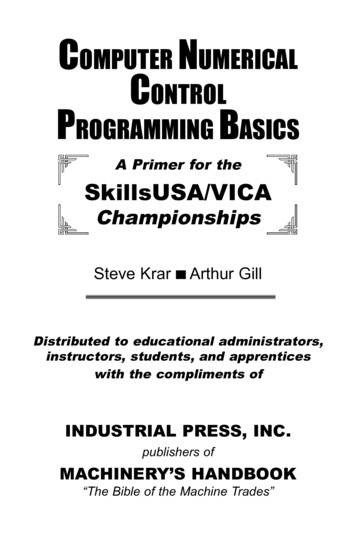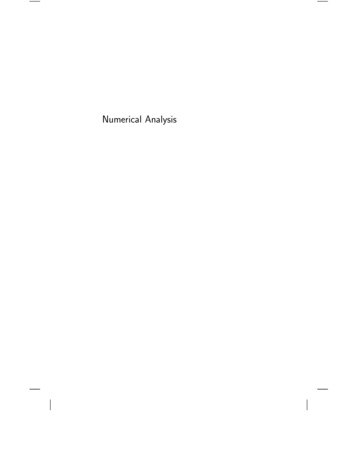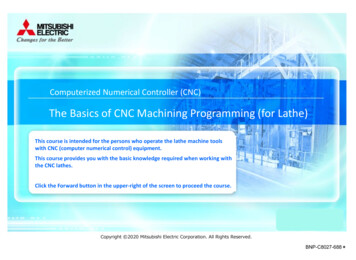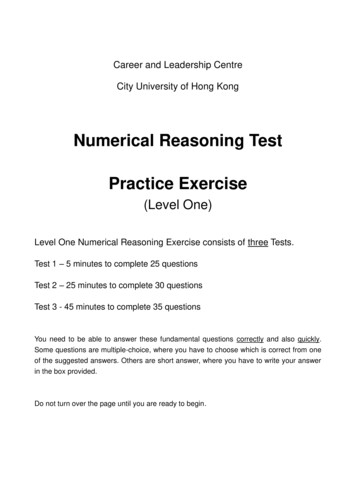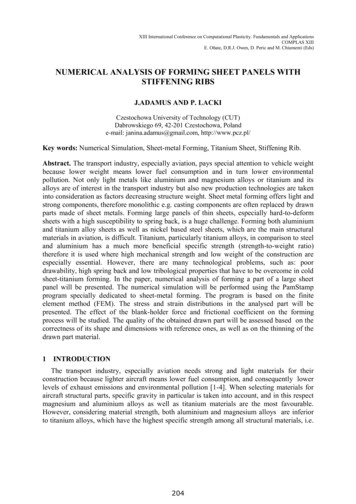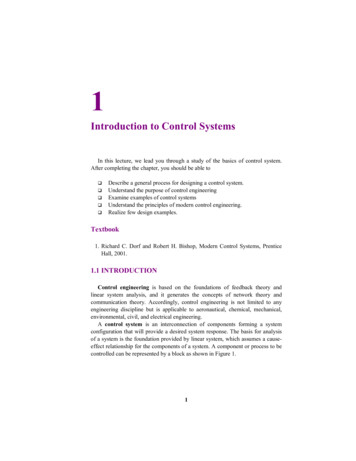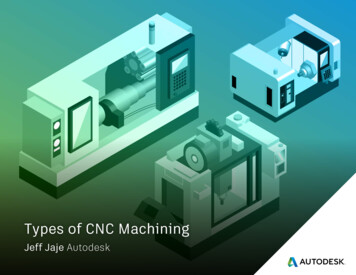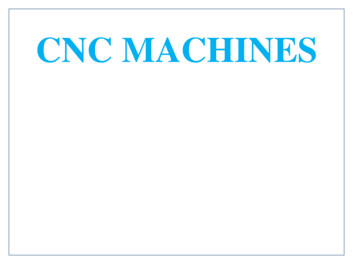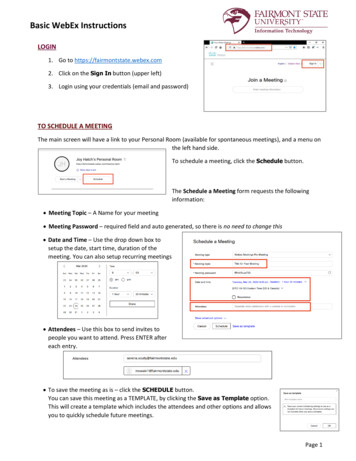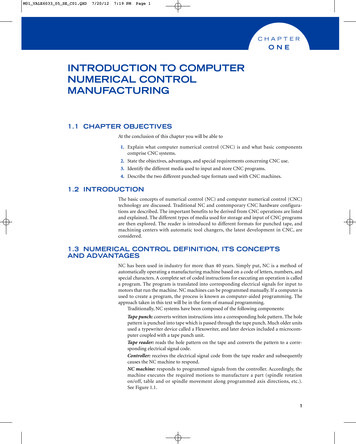
Transcription
M01 VALE6033 05 SE C01.QXD7/20/127:19 PMPage 1CHAPTERONEINTRODUCTION TO COMPUTERNUMERICAL CONTROLMANUFACTURING1.1 CHAPTER OBJECTIVESAt the conclusion of this chapter you will be able to1. Explain what computer numerical control (CNC) is and what basic componentscomprise CNC systems.2. State the objectives, advantages, and special requirements concerning CNC use.3. Identify the different media used to input and store CNC programs.4. Describe the two different punched-tape formats used with CNC machines.1.2 INTRODUCTIONThe basic concepts of numerical control (NC) and computer numerical control (CNC)technology are discussed. Traditional NC and contemporary CNC hardware configurations are described. The important benefits to be derived from CNC operations are listedand explained. The different types of media used for storage and input of CNC programsare then explored. The reader is introduced to different formats for punched tape, andmachining centers with automatic tool changers, the latest development in CNC, areconsidered.1.3 NUMERICAL CONTROL DEFINITION, ITS CONCEPTSAND ADVANTAGESNC has been used in industry for more than 40 years. Simply put, NC is a method ofautomatically operating a manufacturing machine based on a code of letters, numbers, andspecial characters. A complete set of coded instructions for executing an operation is calleda program. The program is translated into corresponding electrical signals for input tomotors that run the machine. NC machines can be programmed manually. If a computer isused to create a program, the process is known as computer-aided programming. Theapproach taken in this text will be in the form of manual programming.Traditionally, NC systems have been composed of the following components:Tape punch: converts written instructions into a corresponding hole pattern. The holepattern is punched into tape which is passed through the tape punch. Much older unitsused a typewriter device called a Flexowriter, and later devices included a microcomputer coupled with a tape punch unit.Tape reader: reads the hole pattern on the tape and converts the pattern to a corresponding electrical signal code.Controller: receives the electrical signal code from the tape reader and subsequentlycauses the NC machine to respond.NC machine: responds to programmed signals from the controller. Accordingly, themachine executes the required motions to manufacture a part (spindle rotationon/off, table and or spindle movement along programmed axis directions, etc.).See Figure 1.1.1
M01 VALE6033 05 SE C01.QXD27/20/127:19 PMPage 2CHAPTER ONEFIGURE 1.1Components of traditional NC systems.NC systems offer some advantages over manual production methods:1.2.3.4.5.6.Better control of tool motions under optimum cutting conditions.Improved part quality and repeatability.Reduced tooling costs, tool wear, and job setup time.Reduced time to manufacture parts.Reduced scrap.Better production planning and placement of machining operations in the hands ofengineering.1.4 DEFINITION OF COMPUTER NUMERICAL CONTROLAND ITS COMPONENTSA CNC machine is an NC machine with the added feature of an onboard computer. Theonboard computer is often referred to as the machine control unit or MCU. Control unitsfor NC machines are usually hardwired, which means that all machine functions are controlled by the physical electronic elements that are built into the controller. The onboardcomputer, on the other hand, is “soft” wired, which means the machine functions areencoded into the computer at the time of manufacture, and they will not be erased whenthe CNC machine is turned off. Computer memory that holds such information is knownas ROM or read-only memory. The MCU usually has an alphanumeric keyboard for director manual data input (MDI) of part programs. Such programs are stored in RAM or therandom-access memory portion of the computer. They can be played back, edited, andprocessed by the control. All programs residing in RAM, however, are lost when the CNCmachine is turned off. These programs can be saved on auxiliary storage devices such aspunched tape, magnetic tape, or magnetic disk. Newer MCU units have graphics screensthat can display not only the CNC program but the cutter paths generated and any errors inthe program.The components found in many CNC systems are shown in Figure 1.2.Machine control unit: generates, stores, and processes CNC programs. The MCU alsocontains the machine motion controller in the form of an executive software program.See Figure 1.3.NC machine: responds to programmed signals from the MCU and manufacturesthe part.1.5 ADVANTAGES OF CNC COMPARED WITH NCCNC opens up new possibilities and advantages not offered by older NC machines.1. Reduction in the hardware necessary to add a machine function. New functions can beprogrammed into the MCU as software.
M01 VALE6033 05 SE C01.QXD7/20/127:20 PMPage 3Introduction to Computer Numerical Control Manufacturing1traditionalORm anuscriPar td(dime escriptionnmanu sions,facturing notes)moreuses modern aPC'spand proachworkstationsTool33 Progradiske m is enterettes,CD's d into MCor istyped U via LANat MCRU's k S-232 caeypable,d.5 Programmedinstructo NC tions sentmachinechangerParman t is 6ufacturedptMachine c o4 Progntrol uramnit(MCpath o medU)f cutterdisplayed(o isptional)2 NCpfor pa rogram genrt manufac eratedtureFIGURE 1.2NC machineComponents of modern CNC systems.FIGURE 1.3 A modern machine control unit.(Photo courtesy of Dejan Lazarevic/Shutterstock.com)2. The CNC program can be written, stored, and executed directly at the CNC machine.3. Any portion of an entered CNC program can be played back and edited at will. Toolmotions can be electronically displayed upon playback.4. Many different CNC programs can be stored in the MCU.5. Several CNC machines can be linked together to a main computer. Programs writtenvia the main computer can be downloaded to any CNC machine in the network. Thisis known as direct numerical control or DNC. See Figure 1.4.FIGURE 1.4Direct numerical control.
M01 VALE6033 05 SE C01.QXD47/20/127:20 PMPage 4CHAPTER ONE6. Several DNC systems can also be networked to form a large distributive numericalcontrol system. Refer to Figure 1.5.7. The CNC program can be input from flash or floppy disks or downloaded from localarea networks.FIGURE 1.5Distributive numerical control.1.6 SPECIAL REQUIREMENTS FOR UTILIZING CNCCNC machines can dramatically boost productivity. The CNC manager, however, can onlyensure such gains by first addressing several critical issues, such as the following:1. Sufficient capital must be allocated for purchasing quality CNC equipment.2. CNC equipment must be maintained on a regular basis by obtaining a full-servicecontract or by hiring an in-house technician.3. Personnel must be thoroughly trained in the operation of CNC machines. In particular, many jobs require setups for machining parts to comply with tolerances of formand function (GD&T).4. Careful production planning must be studied because the hourly cost of operation ofa CNC machine is usually higher than that for conventional machines.1.7 FINANCIAL REWARDS OF CNC INVESTMENTInvestors are encouraged to look to the CNC machine tool as a production solution withthe following savings benefits:1. Savings in direct labor. One CNC machine’s output is commonly equivalent to that ofseveral conventional machines.2. Savings in operator training expenses.3. Savings in shop supervisory costs.4. Savings due to tighter, more predictable production scheduling.5. Savings in real estate, since fewer CNC machines are needed.6. Savings in power consumption, since CNC machines produce parts with a minimumof motor idle time.7. Savings from improved cost estimation and pricing.8. Savings due to the elimination of construction of precision jigs, the reduced need forspecial fixtures, and reduced maintenance and storage costs of these items.9. Savings in tool engineering/design and documentation. The CNC’s machining capability eliminates the need for special form tools, special boring bars, special threadcutters, etc.10. Reduced inspection time due to the CNC machine’s ability to produce parts withsuperior accuracy and repeatibility. In many cases, only spot-checking of critical areasis necessary without loss of machine time.
M01 VALE6033 05 SE C01.QXD7/20/127:20 PMPage 5Introduction to Computer Numerical Control Manufacturing5Using Payback Period to Estimate Investment EfficiencyThe payback period calculation estimates the number of years required to recover the netcost of the CNC machine tool.Payback Period Net Cost of CNC - Net Cost of CNC * Tax CreditSavings - Savings * Tax Rate Yearly Depreciation of CNC * Tax RateUsing Return on Investment (ROI) to Estimate InvestmentEfficiencyThe ROI calculation predicts what percent of the net cost of the CNC will be recoveredeach year. The ROI calculation accounts for the useful life of the CNC machine tool.ROI Average Yearly Savings - Net Cost of CNC/Years of LifeNet Cost of CNCExample 1.1Given the investment figures in Table 1.1 for implementing a new CNC machinetool, determine the payback period and the annual return on investment. The CNC isconservatively estimated to have a useful life of 12 years.Payback Period 95,250 - 95,250 * .163,100 - 63,100 * .46 10,900 * .46Payback Period 2.19 yearsThis calculation estimates that the net cost of the CNC will be recovered in 2.19 years.ROI 63,100 - 95,250/1295,250ROI .57This calculation estimates that the investor can expect 57% of the net cost of the CNC(or .57 * 95,250 54,293 ) to be recovered each year if the CNC machine’suseful life is 12 years.TABLE 1-1Initialinvestment( )130,250One-timesavingsin tooling( )Netcostof CNC( )Averageyearlysavings( )Taxcredit(10%)Taxrate(46%)Yearlydepreciationof CNC( )35,00095,25063,100.1.4610,9001.8 CNC MACHINING CENTERS AND TURNING CENTERSMachining centers are the latest development in CNC technology. These systems comeequipped with automatic tool changers capable of changing 90 or more tools. Many are alsofitted with movable rectangular worktables called pallets. The pallets are used to automatically load and unload workpieces. At a single setup, machining centers can perform suchoperations as milling, drilling, tapping, boring, counterboring, and so on. Additionally, byutilizing indexing heads, some centers are capable of executing these tasks on many differentfaces of a part and at specified angles. Machining centers save production time and cost by
M01 VALE6033 05 SE C01.QXD67/20/127:20 PMPage 6CHAPTER ONEFIGURE 1.6 A vertical spindle machining center.(Photo courtesy of Hardinge Inc.)reducing the need for moving a part from one machine to another. Two types of machiningcenters are shown in Figures 1.6 and 1.7.A more complete discussion of the important features found on machining centers isdeferred until Chapter 4.Turning centers with increased capacity tool changers are also making a strong appearance in modern production shops. These CNC machines are capable of executing manydifferent types of lathe cutting operations simultaneously on a rotating part. A modernturning center is shown in Figure 1.8.FIGURE 1.7 A horizontal spindle machining center with an automatic tool changer andtwo pallet work changers.(Photo courtesy of metalpix/Alamy)
M01 VALE6033 05 SE C01.QXD7/20/127:20 PMPage 7Introduction to Computer Numerical Control Manufacturing7FIGURE 1.8 A modern CNC turning center.(Photo courtesy of Giovanni Burlini/Fotolia.com)1.9 OTHER TYPES OF CNC EQUIPMENTIn addition to machining centers and turning centers, CNC technology has also beenapplied to many other types of manufacturing equipment. Among these are wire electricaldischarge machines (wire EDM) and laser cutting machines.Wire EDM machines utilize a very thin wire (.0008 to .012 in.) as an electrode. Thewire is stretched between diamond guides, and carbide that conducts current to the wire,which cuts the part like a bandsaw. Material is removed due to the erosion caused by aspark that moves horizontally with the wire. CNC is used to control horizontal table movements. Wire EDM machines are very useful for producing mold inserts, extrusion and trimdies, as well as form tools. See Figure 1.9.Laser cutting CNC machines utilize an intense beam of focused laser light to cut thepart. Material under the laser beam undergoes a rapid rise in temperature and is vaporized.If the beam power is high enough, it will penetrate through the material. Because nomechanical cutting forces are involved, lasers cut parts with minimal distortion. They havebeen very effective in machining slots and drilling holes. See Figure 1.10.1.10 CNC INPUT AND STORAGE MEDIAIt will be useful for the reader to become acquainted with the basic concept of binarynumber code prior to discussing input and storage methods. Internally, computers and theMCU operate by a system of electrical switches. A 1 (one) is processed as an open switchand a 0 (zero) is processed as a closed switch. All numbers, letters, and special characters arerepresented in terms of a unique set of zeros and ones. The only code the computer andMCU can work on is binary. All externally generated code must first be translated intobinary before these devices can act on it. The binary code from the computer and MCUmust also be translated back into a code operators can understand. The translation processis automatically executed by devices inside the computer.The information necessary to perform CNC operations could be entered manuallyinto the control unit, but this is a long and inefficient process. The machine is also prevented from making parts while this is being done. Past input media included 1 in. wide
M01 VALE6033 05 SE C01.QXD87/20/127:20 PMPage 8CHAPTER ONEFIGURE 1.9 A CNC-controlled wire cutting EDM machine.(Photo courtesy of James V. Valentino.)FIGURE 1.10 A laser cutting CNC machine.(Photo courtesy of terex/fotolia.com)
M01 VALE6033 05 SE C01.QXD7/20/127:20 PMPage 9Introduction to Computer Numerical Control Manufacturing9punched tape made of paper, paper-Mylar, or aluminum-Mylar laminates. The programwas punched into the tape in a hole pattern.Modern CNC technology uses an array of new devices for storing and loading programs written with the aid of a microcomputer or larger mainframe computer. These areshown in Figure 1.11.DisksThese devices store a program in the form of a magnetic pattern on a plastic disk. Duringoperation, the disk spins and the pattern is read by recording heads in the disk drive unit.Disks, also known as “floppy” disks, can store up to 1.44 megabytes (MB) of information.CD-ROMThe compact disc (CD) is a popular device for storing information in the form of a patternof etched pits. An optical laser is used to read the pit pattern on the spinning disc. CDs offermany advantages over other types of storage devices: they are a very stable and durablemedium, ensuring almost indefinite storage life. Additionally, they are capable of storinglarge amounts of information. A typical CD has a storage capacity of 680 MB. Recordable(CD-R) discs can have data written on them only once. Re-writeable disks (CD-RW) can beerased and rewritten with new data. The CD drive used for this purpose must also be a CD“burner” capable of re-writing data to the CD.Disks and CD-ROMs are used with personal computers (PCs) and workstations. Theyare referred to as random access media. This means that any information on them can befound and retrieved almost instantaneously.Portable Hard DrivesThese palm 1-1 size devices store data in the form of a magnetic pattern on a spinning disk,and are connected directly to any USB port on a PC or workstation. The USB bus power isutilized so no additional power cords or adapters are needed. They dramatically increasethe amount of digital data that can be stored. The smaller pocket hard drive units have astorage capacity of between 2.5 GB and 5 GB. The slightly larger portable units can storedata starting in the 40 GB range all the way up to 120 GB. In essence, they act as additionalhard drives.Computer for generatinga programDisketteFIGURE 1.11CD-ROMMachine Control Unit(MCU)Direct NumericalControl(DNC)Flash orJump DriveModern CNC input and storage methods.PortableExternal Drvie
M01 VALE6033 05 SE C01.QXD107/20/127:20 PMPage 10CHAPTER ONEFlash or Jump DrivesA flash or jump drive is a small, portable unit about the size of a stick of gum that plugsdirectly into a computer’s USB port. Flash memory stores data with the use of a special typeof electrically erasable programmable read-only memory (EEPROM) chip. Data is written byapplying an electric field to the entire chip, or to predetermined sections of the chip calledblocks. Flash drives are available in various storage sizes: 512 MB, 2 GB, 4 GB, and 8 GB.The advantages of using flash devices instead of CDs or external hard drives are listed asfollows:䊏䊏䊏䊏䊏No fragile moving parts that can break if dropped.Far smaller in size.Do not require time-consuming configuration to connect to the computer.USB ports are more common than CD or DVD burners.Flash devices are automatically re-writable and do not require a special drive.1.11 CHAPTER SUMMARYThe following key concepts were discussed in this chapter:1. Numerical control (NC) is a method of automatically operating a manufacturingmachine based on a programmed set of instructions.2. A CNC machine is similar to an NC machine except that in a CNC machine anonboard computer is used to store, edit, and execute programmed instructions.3. CNC use involves substantial investments in equipment, production planning, andtraining.4. CNC machine tools greatly boost productivity.5. Different methods of input include manual data input (MDI); input through punchedtape, floppy disks, zip disks, CD-ROMs, portable hard drives, and flash drives; anddirect transmission from a remote computer (DNC).6. The MCU operates in binary code only. All programs must be translated into binary.7. Storage devices include floppy disks, CD-ROMs, portable hard drives, and flash drives.REVIEW 1.11.1.12.1.13.What is numerical control (NC) and what components traditionally comprised NC systems?What are four objectives of numerical control?What advantages does numerical control offer over manual methods?What is a computer numerical control (CNC) machine?What improvements do today’s modern CNC machines offer over traditional NC machines?What is meant by the terms direct numerical control and distributive numerical control?Name four requirements that must be satisfied prior to using CNC in a shop.Describe four devices for storing and inputting CNC programs.What advantages do flash drives offer over other types of storage media?What is binary code?Name three advantages offered by machining centers.Describe the financial rewards of CNC investment.a. What is estimated by payback period?b. What is estimated by return on investment (ROI)?
Introduction to Computer Numerical Control Manufacturing 3 h s OR NC pr d f ma ure 2 al it(MCU) p (opti onal) d is,. d e t e d r 6 s 4 3 5 n s, s) 1 t FIGURE 1.2 Components of modern CNC systems. FIGURE 1.3 A modern machine control u
